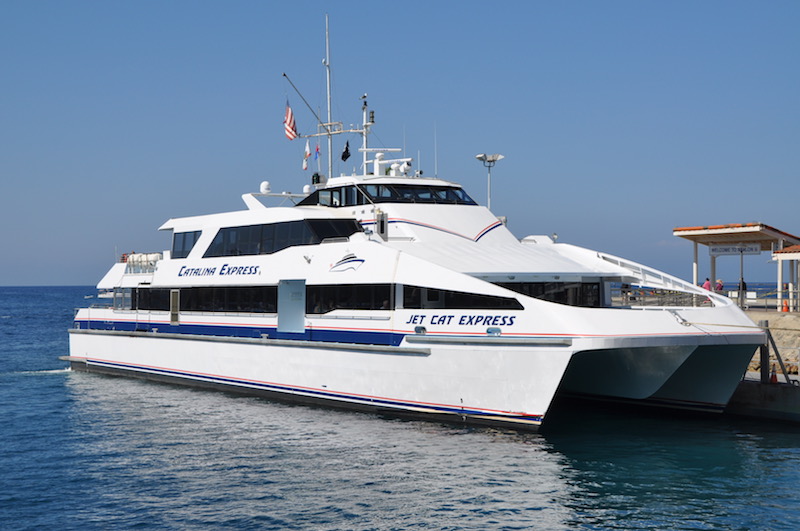I’ve been to L.A./Long Beach several times and have always wanted to hitch a ride on one of Greg Bombard’s high-speed ferries to Catalina Island. Last month, I was finally able to do just that.
Bombard is the president of Catalina Express, which has been providing ferry service to his birthplace, Catalina Island, for 37 years. The company got its start as a commuter service for Catalina residents with one 60-passenger boat. Now, with its fleet of eight boats, Catalina Express transports more than one million passengers to and from the island annually.
The fleet includes four high-speed catamarans — the Starship Express, Catalina Jet, Cat Express and the Jet Cat Express — that travel at speeds of up to 37 knots (43 mph) and make the 22-mile trip from Long Beach in as little as one hour (sometimes less). Passenger capacity on the cats range from 300 to 450 passengers. The four other vessels in the fleet are 150-passenger monohulls.

For a $15 upgrade, Commodore Lounge passengers receive priority check-in and boarding, and a complimentary beverage with packaged snack. The lounge features leather trimmed seats that are wider and recline for comfort. David Krapf photo
On my trip, Greg suggested that I ride on the high-speed cats outfitted with MDI T-foils with computerized ride control systems. So, on the trip over to Catalina Island, I rode on the 134'x34', 300-passenger Starship Express. On the return, I took the 145'x36', 381-passenger Jet Cat Express. As Greg said, it’s all about passenger comfort, so the MDI system is big in that department. I noticed just how smooth the ride was as soon as we got outside Long Beach Harbor and hit our cruising speed of 30 knots. All four all-aluminum cats feature sleek, twin-hull designs. That combined with the MDI T-foils supported by the computerized ride control system to dampen pitch and roll, provide a smooth channel crossing.
“It’s amazing, even on a rough day how flat those boats stay,” Bombard said. “It really makes the boat a whole different piece of equipment. High-speed hydraulics really goes to work, they really do a great job. MDI did a really great job.” MDI’s computer-operated ride control is on all eight boats. The only difference is that the four smaller 149-passenger monohull T-boats have no T-foils.
Catalina Express provides service to Catalina Island from three ports, up to 30 daily departures, and year-round service to Avalon and Two Harbors. The ferries all feature comfortable airline-style seats and grouped table seating.

The Catalina Express fleet includes four high-speed catamarans that make the 22-mile trip from Long Beach to Catalina Island in as little as one hour. David Krapf photo
I asked Greg about any plans for fleet expansion and also what the big issues are for his operation. On the latter, he said not at present. “We’re meeting the demand of what the island needs. If we saw where we couldn’t meet that demand, we would definitely start to build something new.”
The big issue for him and many other operators are EPA emissions regulations. He is closely following the new EPA Tier 4 regulations.
“What we’re watching right now is what this (EPA) Tier 4 brings to us,” he said, “with the urea, the furnace in the bilge, and all the weight that’s been added. And we know that fuel burn is going up by 19 to 20 percent on these new (Tier 4) boats. Let’s stay with the efficiency that we have now because these boats are really efficient. They are as light as you can build them yet the engine horsepower is where it can be and meet the requirements from CARB (California Air Resources Board).”
Bombard thinks the new Tier 4 WETA (Water Emergency Transportation Authority) ferries for San Francisco being built at Dakota Creek Industries will show operators how the new Tier 4 engines, “with all the goodies in it,” perform.
“Fuel burn going up 20 percent … that is a major cost factor,” Bombard said. “And in building one of these new (Tier 4) boats, the price has gone sky high. To build a new Catalina Jet we’re staring down the barrel of something in the $16-million-dollar range. When we were building them (in the late ‘90s, early 2000s), they were nine million. So, prices have gone up and that means you have to take that to the ticket price. Thus, we really want to see what the future is with Tier 4 and the cost factor.”
Besides costs such as labor, insurance, aluminum etc., what has been responsible for the big jump in newbuild costs? “What’s really brought it to this level? I think a lot of it has to do with the engine manufacturer and what they have to do in R&D to get these new engines to perform.”

The Jet Cat Express cruises by the Queen Mary in Long Beach Harbor. Photo by David Krapf
With new vessels and the new Tier 4 engines, the big factor is the additional weight. “And weight is not the thing you want to do on a high-speed ferry,” Bombard said. “It goes against every principle of building a high-speed ferry.”
Currently, the customers are happy, and Bombard and his staff are happy with their present fleet.
“We cruise at 30 knots. We could cruise faster, but we’re giving the engines life and the people are happy with an hour (transit time to/from Catalina Island).”
For Catalina Express and other passenger vessel operators, the name of the game is comfort. That means upgrading such things as seating and interiors. “That’s where you can make some major improvements is in interiors. Lowering the fire load, lowering the weight, yet keeping the comfort. Comfort is the name of the game for us.”
And I can attest to that. It was a very comfortable ride.




